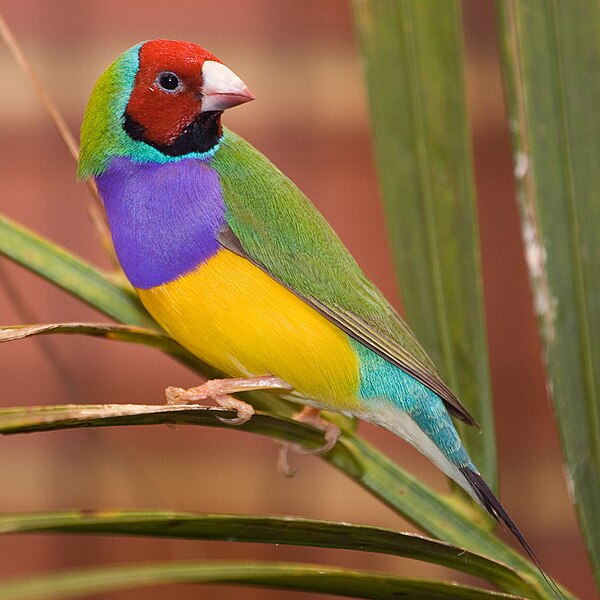The Gouldian finch (Erythrura gouldiae) is at once a popular pet and an endangered species. Large and stocky (for a finch), it boasts a stunning array of 7 bright colors, a fact that has long rendered it among the most expensive of all finches. However, it is now widely bred here in the USA, and prices are coming down a bit.
Color and Male Dominance
 In addition to thrilling bird owners for the past 100 years or so, it seems that the males’ spectacular plumage plays an unexpected role in Gouldian finch behavior as well. Wild Gouldian finches are unique in possessing heads that may be red, black or yellow in color. Red-headed males dominate all others, with yellow headed males being at the bottom of the pecking order.
In addition to thrilling bird owners for the past 100 years or so, it seems that the males’ spectacular plumage plays an unexpected role in Gouldian finch behavior as well. Wild Gouldian finches are unique in possessing heads that may be red, black or yellow in color. Red-headed males dominate all others, with yellow headed males being at the bottom of the pecking order.
Mixing Things Up
To discover if head color granted any specific survival advantage, University of New South Wales researchers applied black dye to yellow-headed males. Although the behavior of the dyed birds did not change, other individuals avoided fights with these formerly bullied males.
When red-headed males were dyed yellow, the former red-heads remained aggressive, but other birds did not readily give way to them at feeding stations (it might be interesting to show the redheads a mirror – maybe they would “realize” they were no longer dominant!).
So it seems that red-headed males truly are more aggressive than others, and that a red head likely confers competitive advantages in activities such as feeding and access to favorable nest sites. Future research will focus on the connection between color and behavior in other species.
Gouldian Finches in the Wild
In the wild, Gouldian finches are limited to small sections of wooded savannah in Australia’s tropical north, and are considered highly endangered.
They live in small groups both in and out of the breeding season and are, as finches go, rather specialized in their feeding habits. Gouldian finches vary their diets with the seasons. For much of the year, sorghum seeds (a grass) are their primary food, but during the rainy season they subsist nearly entirely upon moths, grasshoppers, termites, spiders and other invertebrates.
Next time I’ll go over some special concerns to bear in mind when considering a pair of these lovely birds.
Further Reading
World Wildlife Fund Australia has posted an interesting article on the dire threats facing Gouldian finches in the wild: http://www.wwf.org.au/articles/feature17/
Gouldian finches make wonderful pets and aviary birds, but require more room than similarly-sized finches. Please see my article Bird Cage Overview for further information.
Image referenced from Wikipedia and originally posted by Martybugs.
 That Bird Blog – Bird Care and History for Pet Birds
That Bird Blog – Bird Care and History for Pet Birds




Hi Frank
Really impressive this Gouldian finch! And what an amazing observation regarding different coloration! As well as the fact of the diet switching! I always wanted to ask…I presume chicks are being fed insects as well???
As to the mirror I am in doubt wither the finch would realize it is actually HIM SELF in the mirror. I have seen different birds fighting up to exhaustion with their “rival” in the mirror (in the wild that is). Also many people put mirrors in bird cages for bird to feel not so lonely…But still I think your thought would be worthwhile testing!
Best regards
Gert
Hello Gert, Frank Indiviglio here.
Thanks for the feedback; I agree on the mirror; as far as I know, self-recognition has been proven only with certain mammals (primates, dolphins..perhaps others). I haven’t looked into birds too much re this…crows, ravens would be my starting point.
Most finches, even strict seed-eaters, do feed insects to their young. Many get by without in captivity, but far better results are had when insects are available.
Please let me know if you need any further information. Good luck, enjoy and please keep me posted.
Best regards, Frank Indiviglio.
Hi, I’m considering to have a group of goulddian finch together of around 30 to 40 birds. Just wondering if you know these birds can be housed together? Are they better housed indoor? I’m from Malaysia, the outdoor humidity can be high, around 75%… Thanks
Hi Gerard,
Their native habitat is quite warm and humid…not 75% year round but it gets that high at times. Most breeders favor warm, humid aviaries. They do well in small flocks, and tend to breed well in colonies. I’ve not kept such large numbers, but if given enough space it should be possible. Some problems are likely whenever groups are housed together during the breeding season; extra care is needed at this time – aggression, nest-stealing etc. Please keep me posted, best, Frank
Frank,
If I colony breed gouldians should I use 1 male to 2 female? Is there an advantage to matching the head colors of the pair or colony?
Fran
Hello Fran,
Best to use a 1:1 ratio. be sure to have at least 2 nest boxes per pair, and provide plenty of cover, perches and several food/water stations, as aggression can break out in colonies. No real benefit to matching head color as far as I can see, Enjoy, good luck, and please keep me posted, best, frank